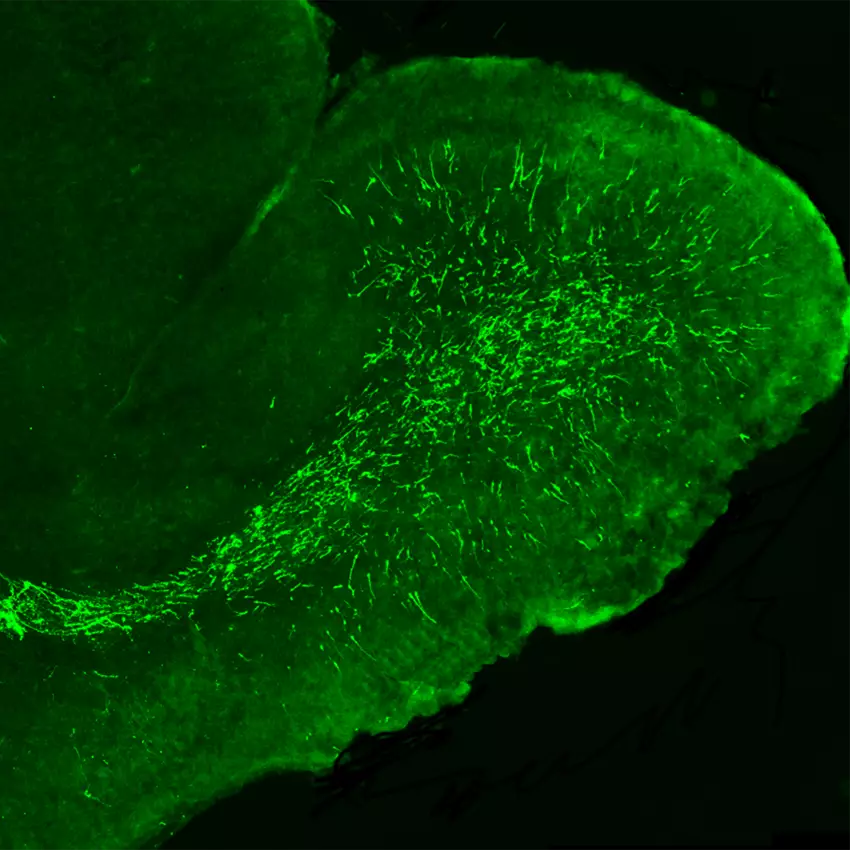Molecular control of neurogenesis
We study the molecular mechanisms that control determination and proliferation of neural stem cells, their differentiation into functional neurons and their deregulation in brain cancer.
In the process of brain development over 1000 different types of neurons are generated from an initially homogeneous stem cell population. At which level is this diversity encoded? How is the proliferation of stem cells controlled to generate the correct number of neurons? What happens when proliferation control goes wrong and brain cancer develops? How do neurons integrate into the circuitry and what is their specific function?
We use the ongoing neurogenesis that occurs in the postnatal mammalian brain to address these questions and identify the signals and molecular cascades that control specific steps in neuron production. A particular focus of our work is set on the role of RNAs that do not encode proteins, but have regulatory functions to provide the stability and flexibility that is needed to generate and maintain a functional brain.
Publications
Disruption of NEUROD2 causes a neurodevelopmental syndrome with autistic features via cell-autonomous defects in forebrain glutamatergic neurons
Stem cell regionalization during olfactory bulb neurogenesis depends on regulatory interactions between Vax1 and Pax6
Neuronal integration in the adult mouse olfactory bulb is a non-selective addition process
Zic-proteins are repressors of dopaminergic forebrain fate in mice and C. elegans
miR-200 family controls late steps of postnatal forebrain neurogenesis via Zeb2 inhibition
Reelin is a detachment signal in tangential chain-migration during postnatal neurogenesis.
Effects of sensory deprivation on glomerular interneurons in the mouse olfactory bulb: differences in mortality and phenotypic adjustment of dopaminergic neurons
Disruption of NEUROD2 causes a neurodevelopmental syndrome with autistic features via cell-autonomous defects in forebrain glutamatergic neurons
Stem cell regionalization during olfactory bulb neurogenesis depends on regulatory interactions between Vax1 and Pax6
Neuronal integration in the adult mouse olfactory bulb is a non-selective addition process
Zic-proteins are repressors of dopaminergic forebrain fate in mice and C. elegans
miR-200 family controls late steps of postnatal forebrain neurogenesis via Zeb2 inhibition
A dual role for planar cell polarity genes in ciliated cells
[Micro-RNA miR-7a controls the production of dopaminergic neurons in the mouse forebrain].
Efficient neuronal in vitro and in vivo differentiation after immunomagnetic purification of mESC derived neuronal precursors.
Plexin-B2 regulates the proliferation and migration of neuroblasts in the postnatal and adult subventricular zone.
miR-7a regulation of Pax6 controls spatial origin of forebrain dopaminergic neurons
Agrin-signaling is necessary for the integration of newly generated neurons in the adult olfactory bulb
Dynamic expression of the pro-dopaminergic transcription factors Pax6 and Dlx2 during postnatal olfactory bulb neurogenesis.
Targeted electroporation of defined lateral ventricular walls: a novel and rapid method to study fate specification during postnatal forebrain neurogenesis.
The SRC homology 2 domain protein Shep1 plays an important role in the penetration of olfactory sensory axons into the forebrain.
Expression and function of CXCR7 in the mouse forebrain.
Coupling between hydrodynamic forces and planar cell polarity orients mammalian motile cilia.
NeuroD1 induces terminal neuronal differentiation in olfactory neurogenesis.
Gene expression analysis defines differences between region-specific GABAergic neurons.
Efficient in vivo electroporation of the postnatal rodent forebrain.
Molecular interaction between projection neuron precursors and invading interneurons via stromal-derived factor 1 (CXCL12)/CXCR4 signaling in the cortical subventricular zone/intermediate zone.
Glial conversion of SVZ-derived committed neuronal precursors after ectopic grafting into the adult brain.
Dynamics of Cux2 expression suggests that an early pool of SVZ precursors is fated to become upper cortical layer neurons.
Purification of neuronal precursors from the adult mouse brain: comprehensive gene expression analysis provides new insights into the control of cell migration, differentiation, and homeostasis.
Reelin is a detachment signal in tangential chain-migration during postnatal neurogenesis.
News
Internal Seminar by Mike Altounian
Join us on 06/07/2023 at 12:30 in Amphi 12 for an exciting talk by Mike Altounian from our team! The title of Mike’s talk will
5 motivated and talented students successfully defended their thesis between September 2022 and January 2023.
NeuroStories 2022: Emprise de tête
Mike Altounian presented his work on the effects of alcohol on neural circuit development at Neurostories 2022.
7 IBDM teams have received grants from ANR
7 IBDM teams have received grants from the Agence Nationale pour la Recherche (ANR) in 2021. Congratulations to Vincent Bertrand, Harold Cremer, Pascale Durbec, André Le Bivic, Pierre-François
In a paper published in elife, Nathalie Coré from the Cremer team describes a new regulatory cascade, implicating transcription factors and a microRNA, that controls how neural stem cells determine which type of neuron they produce.
Neuronal integration in the adult mouse olfactory bulb is a non-selective addition process
A recent study conducted by Jean-Claude Platel in Harold Cremer’s team published in eLife showed that these newly generated neurons add up permanently in the olfactory bulb neural network leading to an increase in the neuronal population and the size of the olfactory bulb.
No jobs opportunities found..

















